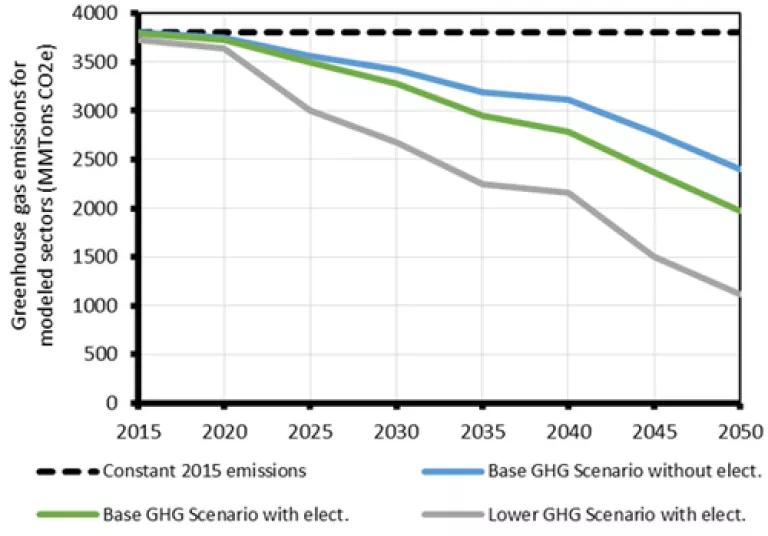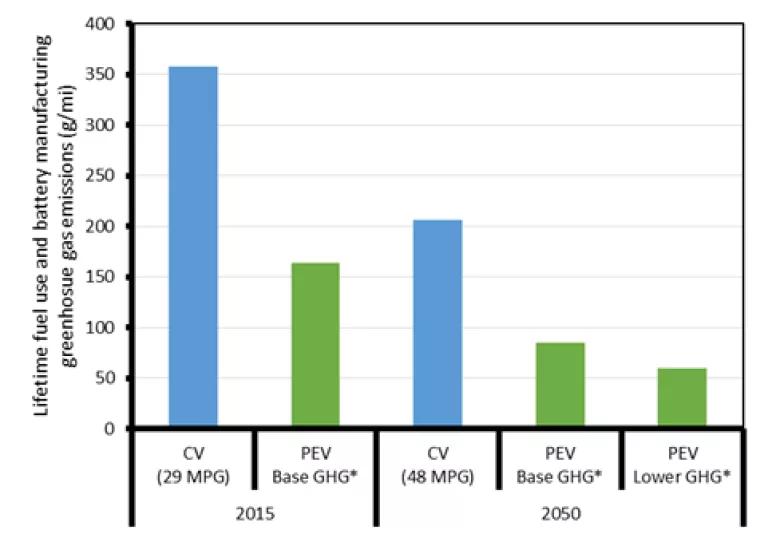Study: Electric Vehicles Can Dramatically Reduce Carbon Pollution from Transportation, and Improve Air Quality

Source: EPRI, NRDC, Environmental Assessment of a Full Electric Transportation Portfolio, 2015.
Producing the electricity to power electric vehicles can generate emissions. But those emissions levels are far lower than the pollution emitted by conventional vehicles, and could be even lower as the electric power sector cleans up over next few decades, according to a new report issued today.
The Environmental Assessment of a Full Electric Transportation Portfolio, by the Electric Power Research Institute (EPRI) and the NRDC, confirms that fueling transportation through electricity instead of petroleum can significantly reduce emissions of greenhouse gases (GHG) and other air pollutants that threaten our environment and health.
Electric vehicles are an essential part of a clean energy future
It's important to consider this study in the context of climate-projection goals that we are striving for: an 80 percent reduction in greenhouse gas emission from 1990 levels by 2050. About 60 percent of carbon pollution from the transportation sector comes from passenger vehicles. If we electrify all of them with renewably generated, zero-carbon electricity by 2050, we will address a huge part of the climate challenge for transportation.
Our study shows that there's a low-carbon pathway with transportation electrification. Advancing policies that continue to clean up the grid and accelerate adoption of electric vehicles will put us on the road to a clean energy future, and one that meets our climate goals.
Electric vehicles and a clean grid are essential to arresting climate change
For the EPRI-NRDC study, we considered two broad questions: 1) what are some potential scenarios for the electricity sector of the future? and 2) what is the potential emissions impact of widespread electrification displacing petroleum consumption in the transportation sector?
To address the first question, we developed two potential greenhouse gas scenarios of the future electric power sector: the "Base GHG" and "Lower GHG" scenarios. Both show grid emissions decreasing over time, in part because of existing and potential regulations and plausible economic conditions. In the Lower GHG scenario, an increasing price on carbon would further reduce carbon emissions, as it would result in faster deployment of low-emission generation technologies.
- In the Base GHG scenario, the study estimates that, by 2050, the electricity sector could reduce annual greenhouse gas emissions by 1030 million metric tons relative to 2015 levels, a 45% reduction.
- In the Lower GHG scenario, the study estimates that, by 2050, the electricity sector could reduce annual greenhouse gas emissions by 1700 million metric tons relative to 2015 levels, a 77% reduction.
Next, we analyzed electric sector and transportation sector emissions with and without widespread vehicle electrification to determine the effect of electrification of light-duty personal vehicles, some medium-duty commercial vehicles like local delivery trucks and certain non-road equipment, like forklifts. We found that electrification could displace emissions from conventional petroleum-fueled vehicles for each scenario:
- In the Base GHG scenario, carbon pollution is reduced by 430 million metric tons annually in 2050--equivalent to the emissions from 80 million of today's passenger cars.
- In the Lower GHG scenario, carbon pollution is reduced by 550 million metric tons annually in 2050--equivalent to the emissions from 100 million of today's passenger cars.
We assume that plug-in electric vehicles (PEVs) are widely adopted, such that just over half of personal vehicle miles are powered by grid electricity by 2050. This assumption is based on a high-penetration estimate by the National Research Council's Transitions to Alternative Vehicles and Fuels.
The figure below shows the combined emissions for the modeled electricity and transportation sectors. We include the Base GHG Scenario without any transportation electrification to illustrate the effects of a grid that is already evolving toward cleaner generation and a transportation fleet with improving fuel economy. When the transportation sector is electrified in the Base GHG Scenario, 2050 emissions are reduced by 48 percent from 2015 levels. In the Lower GHG Scenario, total emissions are reduced by 70 percent from 2015 levels.
Drilling down to the impact on cars, plugging in will result in lower carbon pollution than a comparable conventional vehicle (CV). As shown below, a PEV today has 54 percent lower lifetime carbon pollution today. In 2050, the reduction could be larger, as much as 59 to 71 percent compared to a more efficient CV that achieves 48 miles per gallon in real-world driving, depending on the electricity grid carbon intensity.

*PEV emissions include battery manufacturing emissions and full-fuel-cycle emissions for electricity and gasoline. Utility factor for the PEV is 87 percent, which means 13 percent of the PEV owner's mileage is covered by a gasoline vehicle that achieves the efficiency of the corresponding CV.
Source: EPRI, NRDC, Environmental Assessment of a Full Electric Transportation Portfolio, 2015.
Transportation electrification can improve air quality
In addition to assessing GHG impacts, the EPRI-NRDC Environmental Assessment evaluates the air quality impact of the net pollution changes in 2030 by comparing a base, non-electrified scenario with one that includes transportation electrification.
We find that electrification reduces harmful ground-level ozone, the principal component of smog, because it lowers net emissions of nitrogen oxides (NOx) and volatile organic compounds (VOC). A dominant factor in these reductions was the electrification of non-road equipment such as port cranes and cargo trucks, industrial forklifts and equipment that service aircraft when they are not flying. In most areas of the country the ozone reductions are modest (less than 1 part per billion), but larger ozone reductions are found in areas that need them the most. Many urban areas that fail to meet federal air quality standards today could see reductions of up to 3 ppb from electrification; Los Angeles and Long Beach port areas could see reductions as high as 4 ppb. These reductions could be important for achieving tighter federal ozone standards, which public health and medical organizations have recommended should be tightened from 75 to 60 ppb to protect of public health.

2030 Change in Ground-Level Ozone due to Transportation Electrification
Source: EPRI, NRDC, Environmental Assessment of a Full Electric Transportation Portfolio, 2015.
Our study also found that the reductions in NOx and VOC emissions reduced the formation of fine unhealthy particulate matter (PM2.5) pollution. Again, these reductions were most significant near dense coastal port areas where non-road equipment could be electrified.
The EPRI-NRDC study uses analytical best practices
We believe that the Environmental Assessment effectively captures the emissions impact of transportation electrification because we employed state-of-the-art electricity grid modeling practices. We used a comprehensive national grid simulation model--in this case, the EPRI United States Regional Economy, Greenhouse Gas, and Energy (US-REGEN) model--to determine which power plant types (e.g. coal, natural gas, nuclear, wind, and solar) will be dispatched to supply electricity for charging PEVs. In some cases, it will be served by changes in the use of existing power plants and sometimes the model will project new power plants. A key consideration is the fact that the electricity load attributed to PEVs will grow gradually as new PEVs enter the on-road fleet. Electric utilities will therefore have time to plan on how they will meet the new load. A factor in their decision-making concerning which types of generation to deploy will be the cost of meeting existing and potentially future environmental safeguards. In our modeling of the evolving grid we considered this forward-looking perspective. The study results show that marginal PEV load is met primarily by natural gas, wind and solar. Beyond 2040, our modeled scenarios also make some use of coal plants that capture and sequester their carbon pollution.
A parallel path to clean energy
The EPRI-NRDC analysis confirms that transitioning our transportation sector from its near sole dependence on oil to electricity can lead to big reductions in carbon pollution along with improvements in air quality. Meeting long-range climate targets also requires that we continue to clean up the electric sector. We must implement the Clean Power Plan and follow it with even stronger climate-protective policies. We can, and should, electrify transportation and further clean up the electric sector in parallel. Turning over the fleets of cars, trucks and power plants to cleaner energy sources will take time and we should resolve to make sure it happens.




